HO scale models of Orient Express (2)
Märklin’s recent models coach sets, 42755 and 42760, relate to
The Orient Express as it was in 1921. These sets represent the train between
the end of World War 1 and 1932, during which period, the occupants of the
train were limited to military personnel. Many earlier Märklin models
(and earlier similar models by Trix), also relate to this train, of which
more later.
Märklin have correctly acknowledged the train owner’s trade mark.
Märklin calls it the Orient ExpressTM" - Orient and Occident Deluxe.
In my opinion, neither the words Orient, nor Express, could possibly be trade-marked,
as they are words in common use. However, for a manufacturer to make a model,
they would out of commercial necessity, if not courtesy, acknowledge the “use”
of the name as it relates to that train, and seek approval from the owners,
CIWL.
Märklin goes on to describe the train as follows.
The linking of the West with the Ottoman Empire by rail was an ambitious
project of the countries and railroads participating in it. Probably the best
known connection that still appears in train routings is the "Orient
ExpressTM". The history of this famous train began on June 5, 1883 at
the Gare de l'Est in Paris. The "Compagnie Internationale des Wagon-Lits"
(CIWL) or "International Sleeping Car Company" sent its luxurious
overnight train east for the first time. The rail connection went initially
as far as Rumania, and passengers had to go the rest of the way to Istanbul
by ship. In 1888 it was then complete: Istanbul was connected by ties and
rails to the West. This fast connection between the Orient and the Occident
was not only keenly embraced by business travelers. The elegant clientele
from the ranks of the high nobility and financial potentates also took great
delight in the almost unlimited comfort, in the exquisite catering, and as
well , in the exciting entertainment in the dining car during the long trip.
The rolling stock consisted of first class baggage, sleeping, and dining cars
that were at the highest technical standard for that time. The paintwork for
the cars was in an elegant brown or beige/brown, and the golden coat-of-arms
with the two CIWL lions had to be on every car.
This train soon became a symbol of luxury, on which the guests on board considered
it an honor to travel. The participating state railroads also considered it
an honor to have the train on their rails, and provided motive power for the
train that were the most beautiful, and most powerful locomotives they had
under steam.
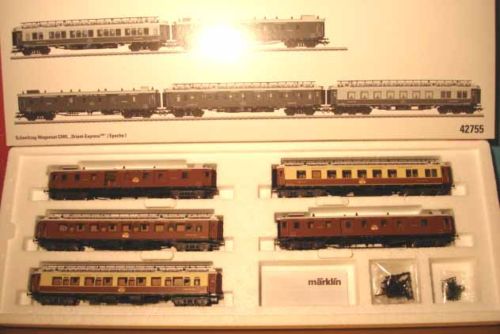
It is at this juncture that we will study the consist of the train. You will notice that the Märklin models, representing the train in 1921, carry the name Compagnie Internationale Des Wagons-Lits Et Des Grands Express Européens (CIWL) on one side, and Internationale Eisenbahn Schlafwagen Gesellschaft on the other side. The cars carrying this name were owned by a German subsidiary of the CIWL. The use of these cars, was pivotal to the train operator gaining the rights to run through Germany, and other sleeper and dining cars would not have been allowed on that train.
The coaches on this train were manufactured as follows:
Märklin Set 42755
#665 brown/beige sleeping – 1900 – Compagnie Générale
de Construction, Saint Denis, Paris, France
#1961 brown sleeping – 1909 – Klett Machinen Fabrik, Augsberg
and Nurnberg, Germany
#1733 brown/beige dining – 1907 - Compagnie Générale de
Construction, Saint Denis, Paris, France
#1204 brown gepack/fourgon – 1908 – Ringhofferovy Zavody and Sp,
Smichow, Prague
#1206 brown gepack/fourgon – 1908 – Ringhofferovy Zavody and Sp,
Smichow, Prague
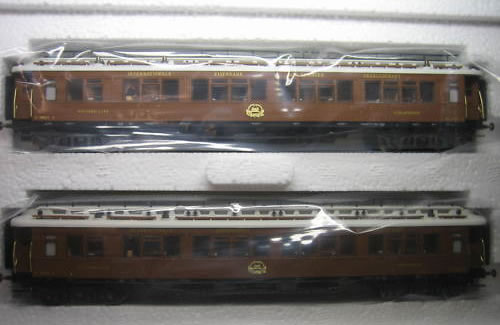
Märklin Set 42760
#1963 brown sleeping – 1909 – Klett Machinen Fabrik, Augsberg
and Nurnberg, Germany
#1958 brown sleeping – 1909 – Klett Machinen Fabrik, Augsberg
and Nurnberg, Germany
It is possible therefore, that these sets could honestly represent a train from the earliest, 1908. I believe models under the Trix brand (and using the same or similar body shells as in 42755 and 42755), have been offered in year’s past. Some have been in the blue and gold colouring of the CIWL, used from 1922 for the Blue Train, which ran from Calais to Marseilles to connect with the Pacific and Oriental ships for India.
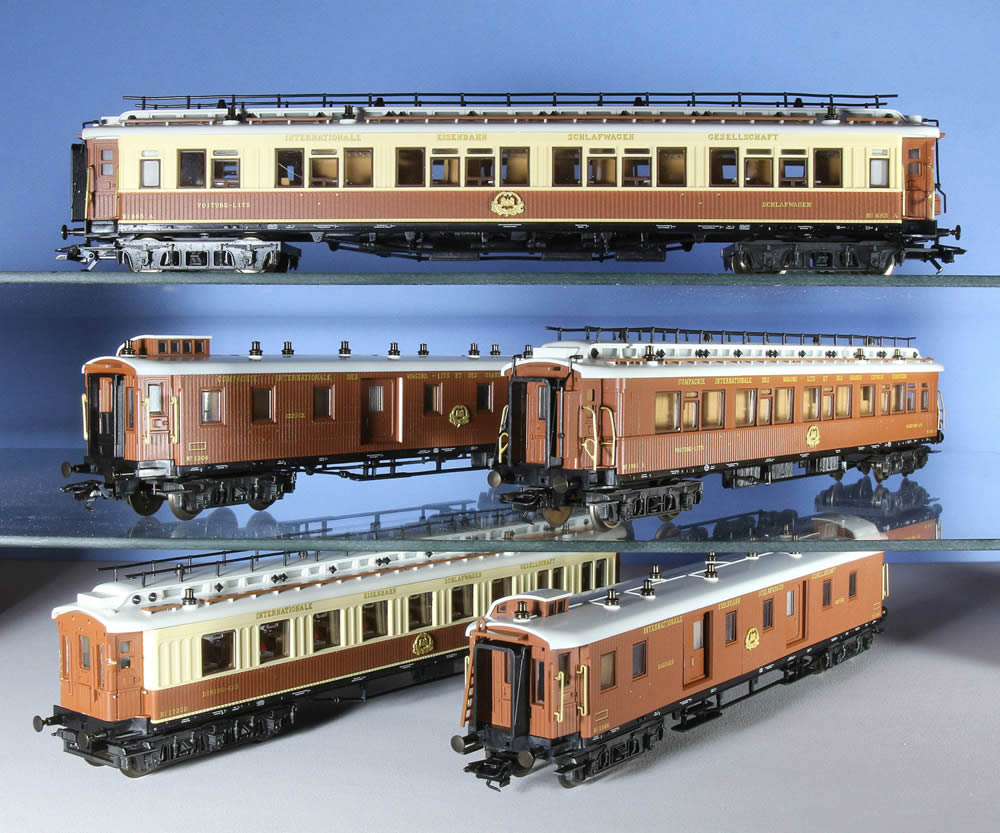
Trix 23426 above.
2015 Boxed sets of Märklin CIWL coaches for the 1928 Orient Express
For 2015, Marklin offered two sets (42795, 42796) in the blue and gold, representing a 7 car Orient Express train, with cars based on the wooden type shown on this page. In this case, Marklin claims they represent coaches as running in 1928. After 1923, the CIWL was investing in all-steel cars, and these were painted blue, possibly to match their Train Bleu running to the south of France. It is equally possible, as wooden bodied cars were refurbished, that the older colours of umber and cream were replaced with blue. The cars are lettered Paris-Karlsbad-Prag. All cars have factory installed LED lighting.
Set 42795
#2180 sleeping car/wagon lits
#2169 sleeping car/wagon lits
#1823 dining carSpeisewagen
#1203 baggage car/fourgon
#1206 baggage car/fourgon
Set 42796
#2171 sleeping car/wagon lits
#2182 sleeping car/wagon lits
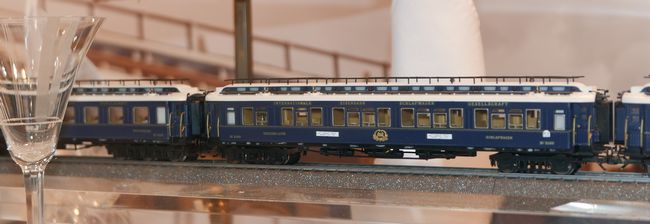

Orient Express in the 1930’s
During the 1932-40 period, the type and colours of these coach sets changed.
From the outset, many newer cars had been built by CIWL in the 1923-30 period.
These new all-steel cars were over 3 metres longer at 23.4 metres, and no
longer had the distinctive clerestory roof. The cars were now painted in the
familiar dark blue associated with the Calais to Côte d’Azur Blue
Train. Märklin have made models of cars representing that period.
The first Märklin models representing cars of the 1930’s were made
from the late 1930’s to 1950, for OO/HO scale, and were numbered 353.
These sheet metal models never carried the CIWL lettering on the headboard,
but did carry the distinctive CIWL leafed gold logo below the waistline, and
the sleeper car (353J) was painted the dark blue of the CIWL. (Model 353 was
the red Mitropa version of the sleeper car, and model 352 was the red Mitropa
version of the speisewagen. ) These models represented the newer CIWL cars
of the 1923-30 construction period, but were based on Märklin’s
model of the German Schürzenwagen skirted smooth-sided cars. One distinctive
feature of the real CIWL cars not modeled by Märklin, was the end doors,
inset from the sides. Because the models were based on the skirted cars, the
doors were flush with the sides. The models carried no numbering.
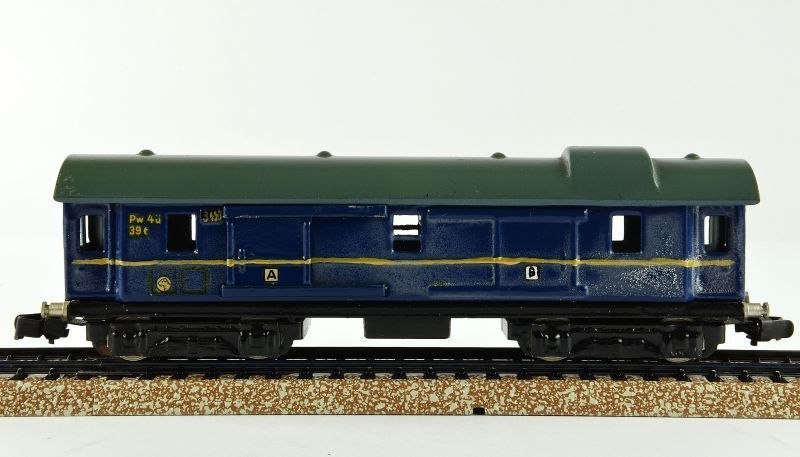
Model 344J above in CIWL colours.
The next models in the Märklin line-up were the 346 series, again built
on the same basics of a newer model of the so- called apron-sided or skirted
cars, known in Germany as Schürzenwagen. In HO gauge the 346/2J speisewagen,
and 346/3J schlafwagen cars were available in the 1950’s in the blue
CIWL colouring that suited the 1930’s. (This colour scheme remained
on the real trains through the four decades to 1977).
However the 346 series were modeled without the Internationale Eisenbahn Schlafwagen
Gesellschaft (ISG) lettering on one side, I guess they really represent cars
used outside Germany (example the Blue Train, or the VSOE etc). But then,
if you are running a model of the Orient Express, who is going to know? The
models do not carry prototypical numbering, but rather the early Märklin
model number, for example 346/2J. These same tin plate models were also available
in the red DSG colouring, which suited post-WWII trains.
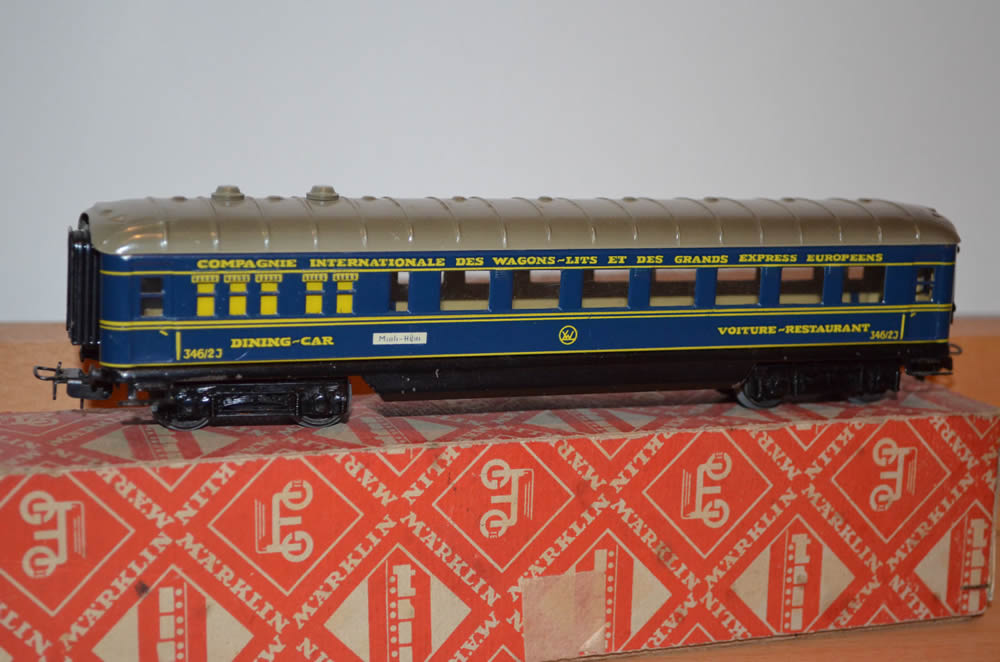
346/2 (later #4008) RED Sheet Metal DSG Speisewagen Dining Car (suitable post-1945)
346/2J (later #4009) BLUE Sheet Metal Speisewagen Dining Car (photo above).

346/3 (later #4010) RED Sheet Metal DSG Sleeping Coach (suitable post-1945)
346/3J (later #4011) BLUE Sheet Metal Wagon Lits Sleeping Coach (see photo
above)
In the period after the second World War, Märklin goes on to say:
The political separation of Europe into Western and Eastern blocks, and
the lean reconstruction years, caused great limitations in the service offered,
as well as in the train's routing. For a while the train ended in Vienna,
Budapest, or Bucharest, and the "Orient ExpressTM" was run as a
normal express train with all classes of cars.
The Marklin Primex 2701 set
In 1988, Märklin produced an "Orient Express" train set (#2701,
with a French ex Nord/ SNCF 230, or 4-6-0 engine, and three passenger cars),
under their Primex brand, which was aimed primarily at the French toy market
through larger general stores.
From the beginning, the London to Paris route of Orient Express in French
territory, was operated by the NORD Railway, and thence by the Chemin de Fer
de l'Est (Eastern Railway), as far as the German border.
There is no point in attempting to rationalize the era, or the reality of
the 2701 set. In my opinion, the train represents that portion of the Orient
Express used on the Calais-Paris Fléche D’Or (Golden Arrow).
The colour of the engine is typical NORD, and it is possible that the train
is set immediately during or after 1938, at which time the French railway
companies had been merged to form SNCF. The ex Nord engine certainly has SNCF
lettering. The brown/cream coach would have been easily identifiable with
the Fléche D’Or. From my research, there were only a few blue/cream
colour coaches, with limited use.
As one modeler (Sulke) aptly said, “For prototypical model railroaders,
these models are enough to make the hair stand on end. But for a friend of
toy trains, especially of tin-plate trains, they make you smile.”
The contents of Primex 2701 were based on existing Märklin models. The
steam locomotive with tender series was of a 230 F SNCF in brown NORD livery
(#230.F.270), based on the Märklin model of the Prussian P8, #3948 and
derivatives from 1967.
The three cars in the set are based on the classic 4037 coach from the Märklin
program. However, they are very finely painted and labeled. The deposit of
the cello window is printed in multiple colors.
The coaches in the set, based on the 4037 sheet-metal models, represented:
1. Pullman saloon cuisine car in brown lower, and cream upper colours, with
gold markings on the cellophane windows, numbered 4037. The real 4037 was
built in 1928 for the Flèche d’Or (Golden Arrow) on the French
side, as a kitchen car with 2 saloons. It was built by CGC, a subsidiary of
CIWL, in Saint-Denis, France. It is probably most prototypical of the three
cars in the set. (A similar car, 4032, is preserved at Telfs Hippological
Museum in Austria). It is rather quaint that Märklin use their model
number as the car number.

2. Pullman saloon/dining car in dark blue lower, and cream upper colours,
with gold markings on the cellophane windows. This model is numbered 3086,
but this number was never used on a real CIWL car. Numbers 3053-3099 were
reserved, but unused by CIWL. As to the colour scheme, it was used by CIWL
on some cars. In 1927-29 new steel cars were built for the Flèche d’Or
(Golden Arrow) and other CIWL associated trains such as the P&O Overland
which ran Calais-Marseilles-Joliette. CIWL restaurant car numbers 2444, 2445
and 2446 were painted blue lower, and cream upper panels, for use in the Golden
Mountain Pullman Express in Switzerland, from 1931.
3. CIWL sleeper car numbered 2701 in dark blue, with gold markings on the
cellophane windows. The real 2701 was an all-steel car WL type, Class S2,
built by Savigliano of Turin, Italy in 1926, possibly for running in Italy.
It is possible that the model is reasonably representative of the prototype,
though it lacks the cross ribs of the roof, which were quite prominent. The
window spacing is not particularly representative of a sleeper car. The car
carries the CIWL lettering on the headboard above the windows on one side,
and ISG lettering on the opposite side. The gold (brass) CIWL logo is well
represented below the waist on each side.
As a complement to this 2701 set, Märklin Primex offered three more
cars, which were sold separately in 1991-92:
1. Märklin / Primex # 4186, Luggage van/Fourgon for the Orient Express,
CIWL lettering on the headboard, logo below the waist, and in dark blue, with
gold markings on the cellophane windows. This model is numbered 4186. The
4186 van is also based on the 4037, but its construction is a real form of
novelty. This form is used again in 1995 for a pseudo-Wurttemberg van by the
Hobby (amateur) program (Märklin 4186). The roof of this car deserves
notice: It is the 4037-roof and roof ventilators, but the chancel space in
the center of the roof, is made of plastic. There never was a CIWL car # 4186.
The number series 4177 to 4200 was reserved, but never used by CIWL. Do I
detect a certain wry humour from the planning and production staff at Märklin?
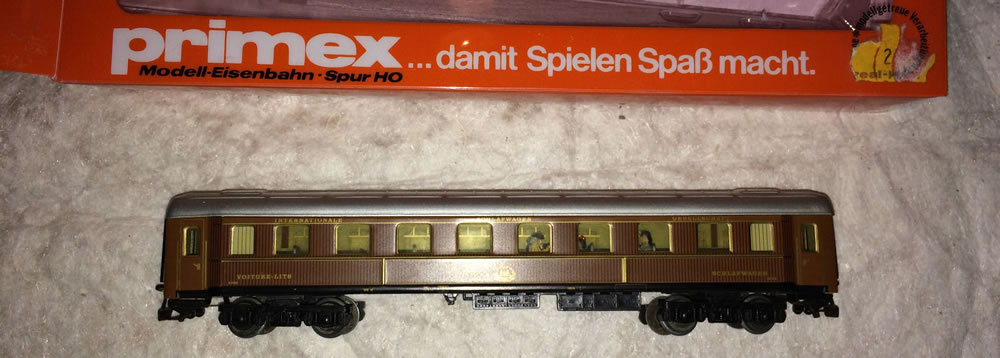
2. Märklin / Primex # 4191 - CIWL teak (brown or umber coloured and lined
to look like jointed boards) sleeper is also based on the 4037, although here
the roof pressing is the same as used on the rather rare Märklin 4036
D-coaches of the FS. It has the exposed ribs, more like those generally used
on CIWL cars. I don’t know the number used by Märklin on this car.
3. Märklin / Primex # 4196 – a bright red Speisewagen of the Mitropa
company. While not a car normally associated with the CIWL trains, I believe
it may have been used in cases of shortage. Mitropa was re-formed in 1946,
to become DSG. The model is numbered 1016.
As an alternative express locomotive for the 2701 train set, you could use the Märklin 3083, produced from 1977-82. This model represented the ex. S 3 /6, then 231,981 of the ETAT (Chemin de Fer de l'État (State Railway) formed in 1909. It is a perfect fit, with its bright brass-colored rings on the boiler, and the chrome tires, making for a visually striking train. Märklin never produced a really suitable set of cars for this locomotive #3083.
Orient Express models boxed sets
The Maerklin Orient Express models in a layout setting
Link to the history of the Orient Express.